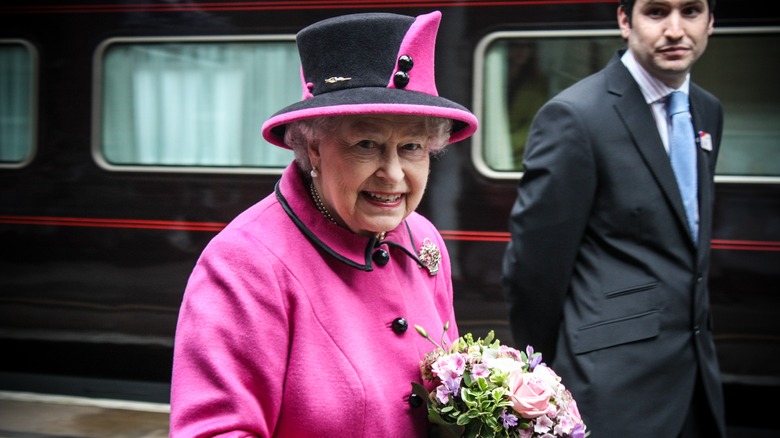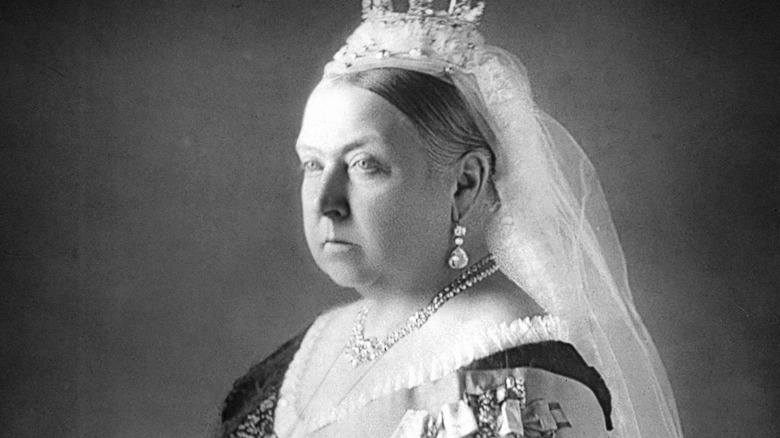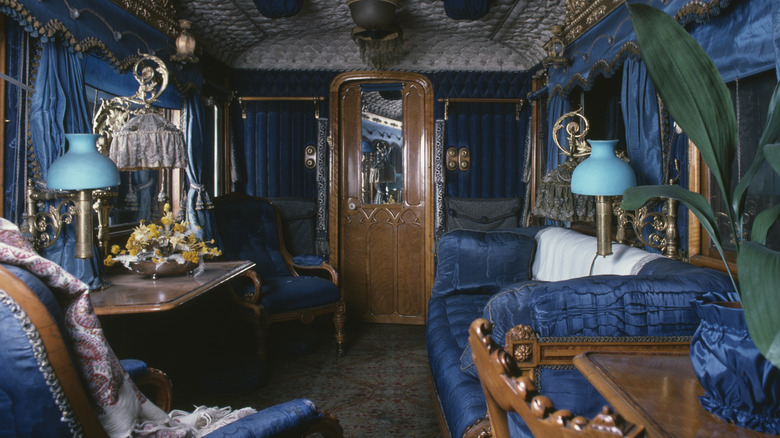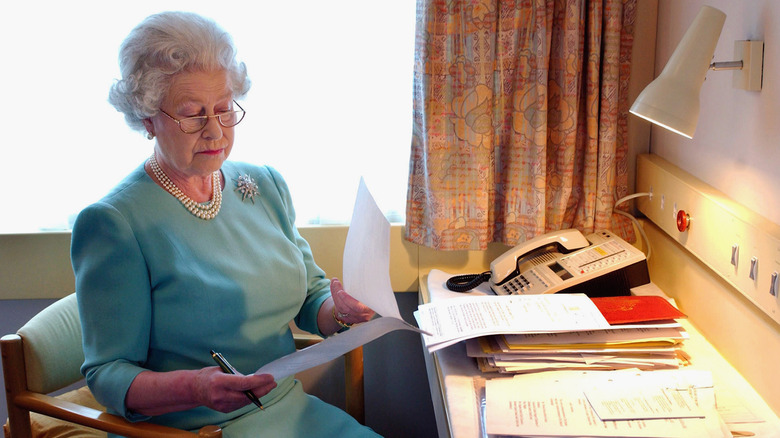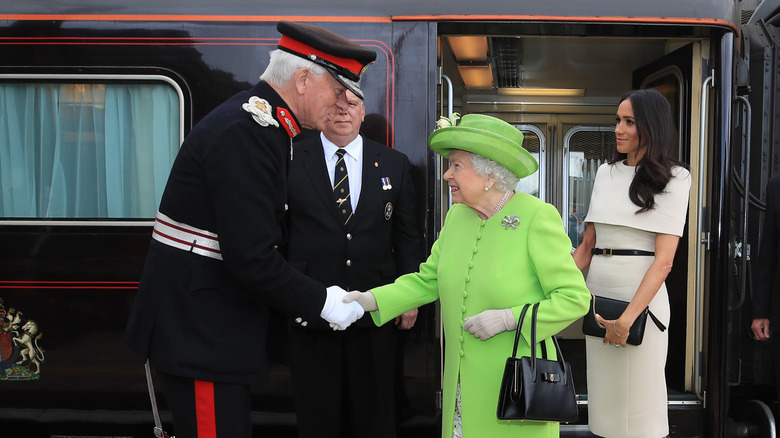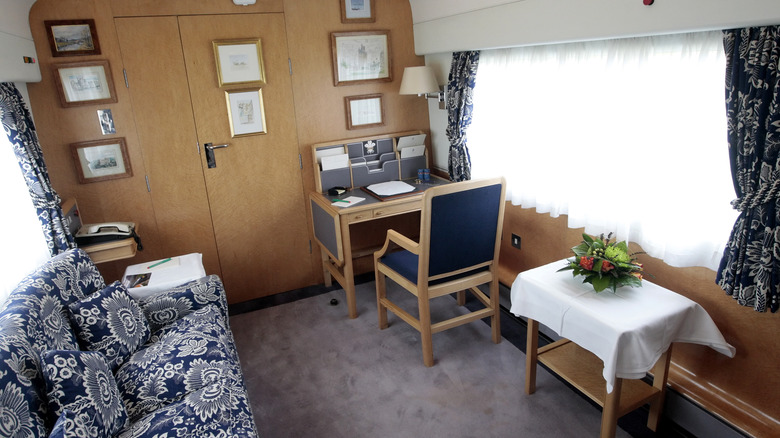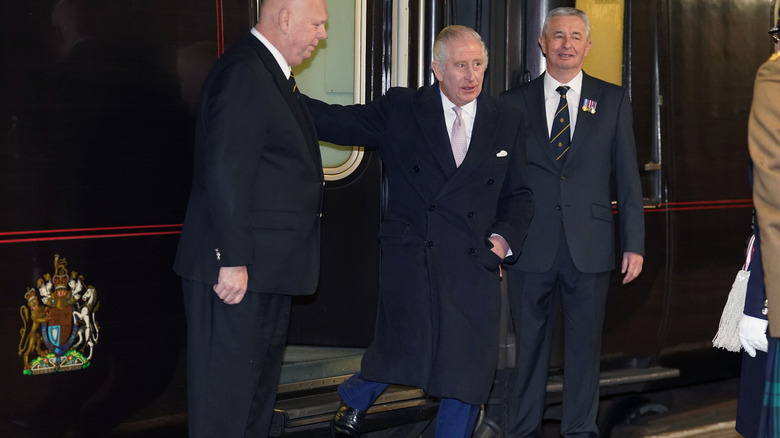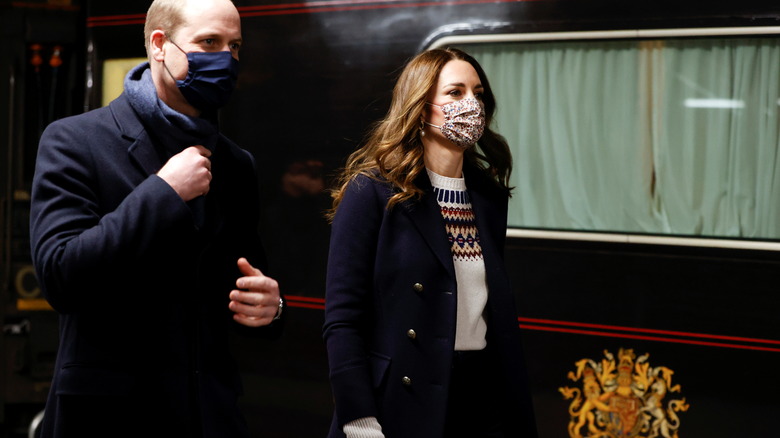What It's Really Like Inside The British Royal Train
Much of the information about the royals that were a secret until the 21st century is now publicized information. The royal train is also part of the once-secret-now-public royal legacy. Any knowledge of the train was a secret up until 1946. Understandably, because royals then took the train much more frequently than present-day royals. The existence of this luxurious mode of royal transport was made public knowledge only after World War II ended. During the late 19th and 20th centuries, the royal train was the preferred mode of transport for British royalty. From Queen Victoria's time to the present day, the royal train has been frequently used by monarchs. After the retirement of their beloved yacht, Britannia, in 1997, the royal train has been the favorite personal mode of transport among the British senior royalty.
According to the PBS documentary series, "Secrets of Royal Travel," a trip on the royal train is a more expensive royal affair. It's four times more expensive than taking a flight, costing about £52 per mile, but is apparently the royals' favorite way to travel (per YouTube). And the annual taxpayer cost of the train comes up to £800,000 (per Express).
Now, what exactly is this royal train? What is it really like inside this extravagant transportation? According to royal train expert Phil Marsh, the British royal train is the "most romantic train in Britain" (via YouTube).
Queen Victoria was the first monarch to travel by train
In 1842, at the age of 23, Queen Victoria became the first-ever royal to travel by train. Although the queen was not a huge fan of locomotives, her husband Prince Albert was a patron of them and it was his push that made her commission the first royal train. As royal historian Kate Williams explains, "Victoria has a completely different attitude, in which she feels very strongly that it's her job to go traveling around as much of Britain as she can, so the royal train makes it easier for her" (via Yahoo). The first royal train trip was about 18 miles — from Slough to Paddington.
Throughout her reign, Queen Victoria made upgrades to her coach, including satinwood and bird's eye maple chairs with intricate designs and blue silk cloth, in classic Victorian-era style. Since the queen multi-purposed her coach as a study and work space, there were sofas, writing tables, and lamps, as well. She had different buttons that, when pressed, would bring the staff to her service or stop the train. Electric lighting and modern plumbing were also added.
As noted by the documentary, "Royals on Rails: The Inside Story of Britain's Royal Train," Queen Victoria preferred not to eat or use the royal toilet on the train, as she was always "a little bit wary of some of the new technology" and did not like moving around in the carriages (via YouTube).
Modifications were done to the train by different monarchs
The royal train has been periodically upgraded throughout the years. For instance, King Edward VII ordered a luxurious green velvet saloon carriage furnished with mahogany and plush seating. When King George V, Queen Elizabeth II's grandfather, traveled around the country during World War I, he upgraded the carriages to include lodging facilities, as he wasn't comfortable with burdening his subjects with the duty of hosting the king. Under his reign, the royal train was fitted with a bathtub, which apparently was the first-ever on a train. The tub had a red line to hint at the water level. For much of England, this was an economic measure to save fuel during World War II, but on the train, it was likely to prevent water from spilling out of the tub.
During World War II, King George VI used the train to visit the places bombed by German troops. Understandably, the security measures in the royal train were upped during this period. This round of refurbishment saw the addition of 56-ton steel armor plating, which made the British royal train the heaviest passenger train to ever ride the British railways. The train also had secret cabinets to store sensitive documents.
All these carriages which are now not in use are housed at the National Railway Museum in York.
The current royal train was gifted to Queen Elizabeth II in the '70s
In 1977, to celebrate Queen Elizabeth II's Silver Jubilee tour, the presently used version of the royal train was presented to the queen. In this version of the train, the extravagant interior from Victorian times was traded for a more functional, modern look.
"Everyone presumes that the royal train is extremely luxurious, and it's a bit like the Orient Express, but in practice, it's more functional than flamboyant," said royal historian David McClure (via YouTube). The current version of the royal train is painted in royal claret — a deep burgundy shade.
Since then, various modifications were further made to the carriages. In the 1980s, the defense of the train was upgraded with methods of protection from various forms of attacks including machine-gun fire, bombs, and rockets. Small changes to include the personal preferences of the senior royals, including Elizabeth and Prince Philip, were also incorporated. For instance, a shaving mirror was installed by the toilet under Philip's orders.
The train has nine carriages with dedicated spaces for senior royals
The interiors of the British royal train are designed to put the comfort and work of the royals over aesthetic beauty. Presently, the British royal train has nine carriages, including bedrooms, bathrooms, dining areas, and workspaces. As reported by Express, King Charles has his own space with a bedroom, bathroom, and study. The king's space is decorated with a blue and white sofa and curtains to match, along with a small desk. Additionally, there are no double beds in any of the carriages.
Previously, Queen Elizabeth II and Prince Philip had their own quarters on the train, and it is yet to be confirmed what will be done to those spaces. The queen's carriage was 75 feet long and had electric heating and air conditioning. She also had a personal bathroom with a full-sized bath and personal dining quarters. Her bedroom had paintings featuring beautiful Scottish landscapes. Philip's carriage had a similar design to the queen's, but it had green curtains and cushions with brown carpets. His quarters also boasted a private kitchen.
Since it is customary for new monarchs to customize and personalize the royal train, we will have to wait to see the changes King Charles is going to make.
What food is served on the British royal train?
Although Queen Victoria believed that it was unhealthy for your digestive system to eat on the train, in the present day, the meals are prepared to the same standard as the Buckingham Palace kitchen.
In a 2008 article by The Daily Mail, the culinary secrets of this luxurious mode of transport were explored. According to the article, if the queen departs at night, she gets "light refreshments of smoked salmon, warm sausage rolls, and chicken or egg sandwiches made with brown and white bread — all with the crusts removed." It is revealed that the monarch was the queen of consistency and used to have the same breakfast every time she rode the train: Scrambled eggs with bacon, which she normally had while catching up on her morning paper reading. On overnight journeys, the queen preferred to be woken up early with a cup of Earl Grey.
Guests who can travel the royal train only with a formal invitation from the monarch are also taken care of very well by the royal kitchen staff. Per The Daily Mail, they are welcomed with "silver salvers with crystal glasses of chilled Champagne, buck's fizz, or fruit juices" and dine at the 12-seater dining table in the train's dining quarters.
The royal train is not as fast as you might think it is
Queen Victoria's pace of train travel was a maximum of 40 miles per hour during the day and 30 miles per hour at night. Now, this was a personal preference, because the trains, even in her times, were capable of moving much faster than that. Historians speculate that this was due to the time's superstitions which made some believe that people who traveled via fast railway would "injure the brain," according to "The Invisible Plague: The Rise of Mental Illness from 1750 to the Present."
Even in the present day, the royal train is not the fastest train in Britain — the royal train goes at an average of 70 miles per hour, while the fastest ones go about 200 miles per hour. Staff members are deployed to make sure that the royal train doesn't hinder the schedule of other faster trains that might share the same route.
Although they aren't as fast as one would think, the British royal train is famous for being on time, consistently arriving within 15 seconds of its scheduled arrival time (per Town & Country).
Who uses the British royal train?
In January 2023, King Charles brought attention back to the British royal train when he took an overnight ride to Manchester from Scotland. This was his first time on the train since becoming monarch. Before this outing, in 2020, Prince William and Princess Catherine had used the service of the British royal train for their U.K. tour that was focused on visiting individuals and organizations that were at the forefront of the COVID-19 crisis. This tour saw local artists and performers showcasing their art in an effort to boost the country's arts and culture industry.
In 2018, Meghan Markle rode the train with Queen Elizabeth II to go to Cheshire, where they attended their first royal engagement. Both these journeys created history, as the royal train was previously reserved for the senior-most royals — Elizabeth, Prince Philip, Charles, and Camilla, the queen consort. Even Prince Harry has not been able to ride the royal train yet. Throughout the years, the royal corgis were also the train's passengers.
Throughout 2019 and 2020, the train was used only three times — twice by William and once by the queen. Ultimately, the royal train is as luxurious as any other royal indulgence. With good reason, though, because the primary purpose of this service is to make sure that the royals are at their best selves for their next royal engagement.
